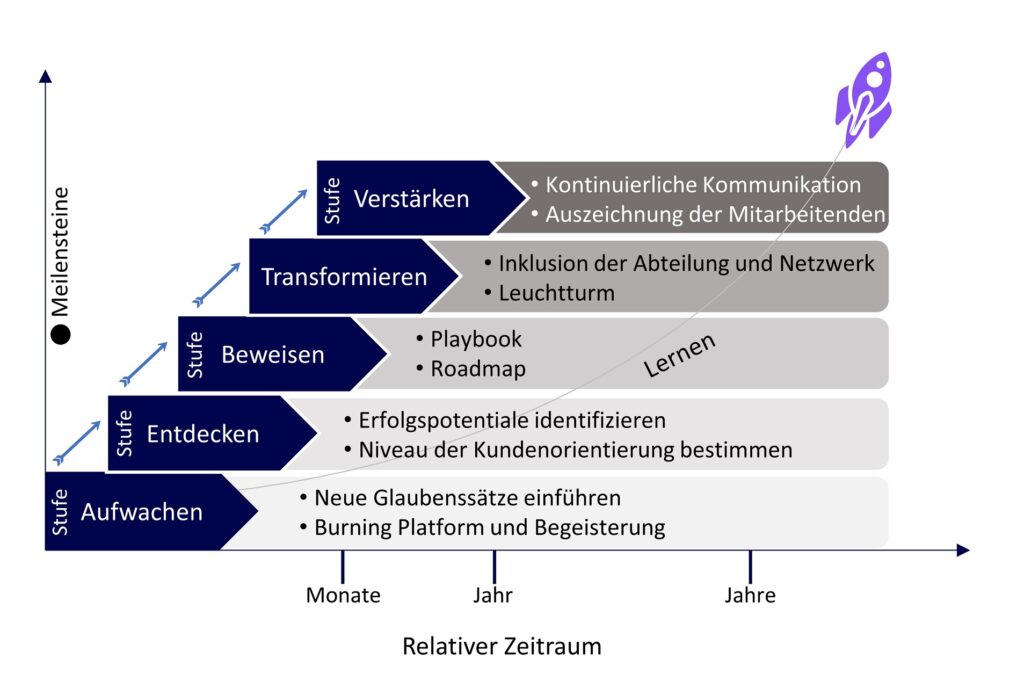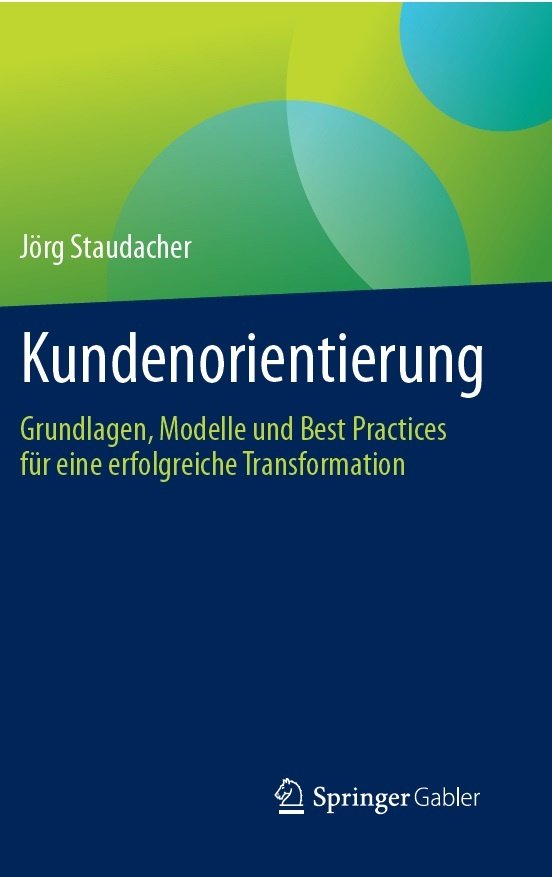In order to better understand the process for improving customer centricity, the first step is to take a closer look at possible deficits in optimizing customer centricity:
- Reduction of customer centricity to customer management
- Too much focus on the operational measures of customer management
- Conceptual and methodological deficits in the determination of customer value and customer net benefit (customer-firm value)
- Lack of utilization of developed customer segments
- Equating customer satisfaction and customer loyalty
- Neglect of soft skills (leadership and culture in the implementation of customer centricity)
- Isolated optimization of individual aspects of customer centricity – without coordination with each other
Customer orientation is a dominant logic that also affects leadership, culture, competence management and processes, and not just
customer management. The reduction of those responsible to individual aspects of customer centricity is to be stopped with the process visualized above.
The five stages of the process for improving customer centricity
The first stage of the process to improve customer centricity is to get the organization excited about the topic of customer centricity. If possible, the elements “Burning Platform”, “Prophet” and “Reduction of retarding forces” should be combined. This stage can be compared to waking up in the morning and should therefore be done very gently. Most organizations will have followed a different Dominant Logic to date. Management is challenged to introduce new beliefs into the organization, thereby establishing a baseline understanding regarding urgency, but also initial enthusiasm. In addition, it is important to achieve an initial impetus for improving customer-centric commitment and subsequently customer-centric citizenship behavior by taking standards and artifacts into account. Customer centricity in the wake-up stage can only be top-down. All approaches from individual departments or business units will fail sooner or later. In addition, standards and artifacts are important elements for improving customer centricity. These are to be based on the beliefs. The two core beliefs are that customers are the reason we work together and customer focus increases profits. As a basic norm, set the default that every decision in the organization must be based on customer insights and should increase customer-firm value.

The second process stage of the customer centricity improvement process is to understand the existing level of customer centricity as well as the respective strengths and weaknesses and to discover possible potentials. For this purpose, our Customer Centricity Maturity Check in 8 can be used as a first step. After the initial assessment by means of the Customer Centricity Maturity Check, the interview guide can be used to check the individual readiness for change at the management level. Depending on the results of the Customer Centricity Maturity Check, this enables management to analyze how transformation requirements and readiness relate to each other. These findings must be supplemented with understanding regarding the potential for success. Building on the trend analysis, the customer purchase process analysis and the supplementary acquisition of customer insights based on the customer-firm value analysis, the aim is to determine and evaluate success potentials for the organization. Subsequently, strategic initiatives should be developed based on the internal strengths and weaknesses as well as the external potential for success. These are to be evaluated in a further step. The main focus here is on strategic wins. Here, too, it is worth repeating: improving customer centricity has a medium- to long-term perspective. It may be helpful at this point to develop different design options for each strategic initiative. Strategic work is primarily aimed at learning rather than correctly predicting the future. Working through different options for each initiative is helpful in keeping the learning curve high.
The third stage of the process to improve customer centricity is for management to prove itself to employees. Most organizations tout that they are customer-centric. But very few employees believe that. A roadmap and a playbook are to be used to communicate clearly to every employee what the goals are with regard to customer value-based decision making, which areas are affected by customer-centric transformation, how co-creation will be developed further, and how customer management will be adapted. It should not be forgotten that these two elements in the sense of artifacts play an important role in influencing customer-centric commitment and customer-centric citizenship behavior.
The fourth process element “Transform” is not so much a stage as a continuous activity. It covers a significantly longer period than the previous stages. Customer management should always be adapted only when the organization has the necessary competencies as a result of the transformation. In the past, the focus on improving customer centricity was on resources in terms of budget and often technology. Customer-centric transformation focuses on employees and encompasses the entire organization. The two most important elements are successfully implementing a lighthouse and ensuring inclusion. Even though the approach and the term lighthouse has been burned in many organizations in the meantime, it is still important to achieve continuous successes at individual points in the organization and to keep the enthusiasm for the topic of customer centricity high. Successes are to be divided into result successes and learning successes. Management is required to continuously communicate successes in improving customer focus over time. We have yet to see an organization that communicated individual successes over time too extensively. There is also a need to focus more on changing the organization rather than changing customer management. The better the transformation capability, the higher the potential for optimally shaping customer management. In general, we can only wish the organizations more courage in internal communication. In addition, attention must be paid to inclusion during transformation. Inclusion affects the different departments as well as the entire network. Power, fears, heterogeneous competencies and much more will sooner rather than later slow down the customer-centric transformation like chewing gum.
However, no organization can be constantly changed. Transformation means entering a refreezing phase again and again. The last stage of the customer orientation improvement process, “Reinforce,” is to practice and perfect the changes in the organization before a new change cycle can be started. This is why planning is an important element of customer centricity, not only in the context of customer management, but also for customer-centric transformation.





